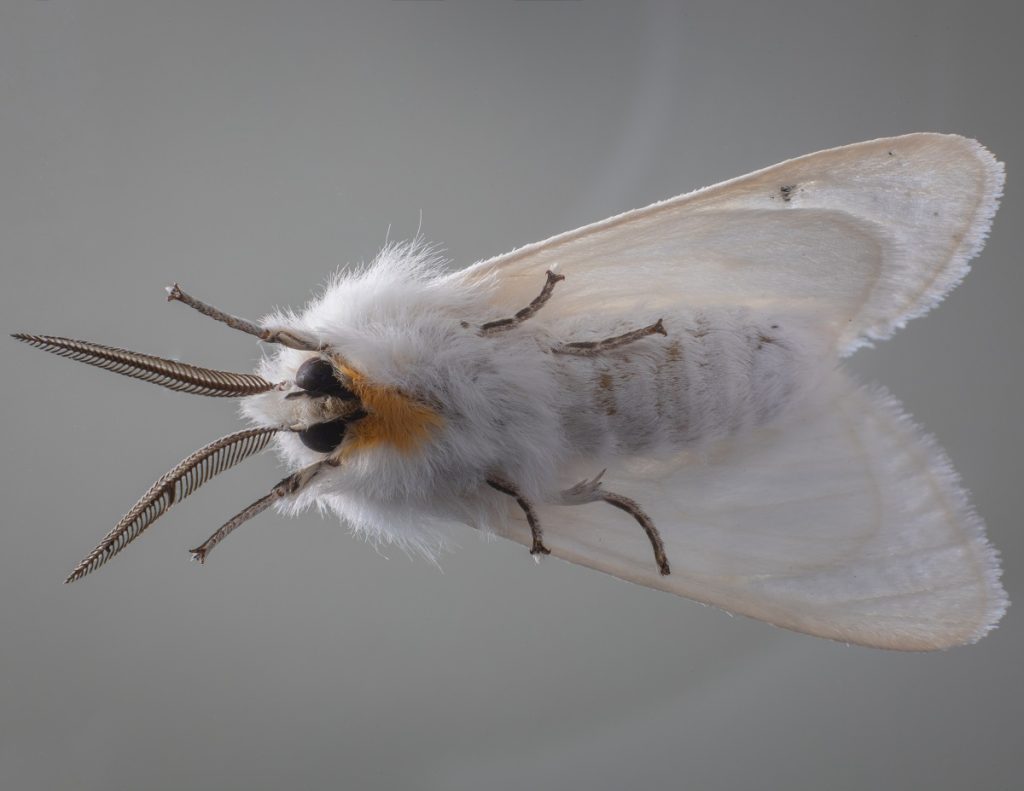No, moths are not blind. Moths, like most insects, have compound eyes that allow them to perceive their environment. However, their vision is quite different from that of humans.
Moths’ compound eyes are made up of many small, individual lenses called ommatidia. These lenses can detect light and motion, but they may not see details as sharply as humans do. Moths are often more sensitive to ultraviolet (UV) light, which is invisible to humans, and this helps them navigate and locate nectar-rich flowers.
How do moths’ compound eyes differ from human eyes?
Moths, like many other insects, possess compound eyes. These eyes are fundamentally different from the single-lens eyes found in humans and many other vertebrates.
Moreover, compound eyes are so named because they consist of thousands to tens of thousands of tiny lenses known as ommatidia. Each ommatidium is essentially a separate visual unit.
Furthermore, the compound eye structure provides moths with a mosaic view of their surroundings, meaning they perceive multiple, overlapping images from different ommatidia.
This mosaic view contributes to their ability to detect motion and changes in light intensity effectively.
Number of Lenses (Ommatidia)

- Ommatidia Density: The number of ommatidia in a moth’s compound eye can vary depending on the species. Some moths have relatively fewer ommatidia, while others have a higher density.
- Sensory Variability: The density and arrangement of ommatidia can affect the moth’s field of vision, sensitivity to light, and the level of detail they can perceive.
- Enhanced Peripheral Vision: Moths typically have excellent peripheral vision due to the arrangement of their ommatidia. This wide field of view is advantageous for detecting predators and other threats.
Comparison with Human Eyes
| Characteristic | Moths’ Compound Eyes | Human Eyes |
| Structural Differences | Structurally distinct compound eyes | Single-lens simple eyes (camera-type eyes) |
| Visual Acuity | Prioritize detecting motion and changes in light | Adapted for high visual acuity |
| Color Perception | Generally limited color vision, sensitive to UV | Wide range of color perception |
| Nocturnal Adaptations | Adapted for low-light conditions | Optimized for diurnal (daytime) vision |
What is the significance of moths’ sensitivity to UV light?
Moths are highly adept at detecting motion. This ability is crucial for their survival as it helps them identify potential threats, such as predators or approaching objects.
Moths can react swiftly to changes in light and motion. For example, when a moth senses the shadow of a predator approaching, it will often initiate evasive maneuvers or take flight to avoid capture.
In addition, moths are primarily nocturnal creatures, and their compound eyes are well-suited for low-light conditions. They can perceive even subtle changes in light intensity, allowing them to navigate effectively in the dark.
Sensitivity to Ultraviolet (UV) Light
- UV Vision: Moths are known for their sensitivity to ultraviolet (UV) light, which is invisible to the human eye. Many flowers and other objects in their environment reflect UV light differently from visible light, and moths can detect these patterns.
- Nectar Detection: This sensitivity to UV light is particularly important when moths are seeking nectar from flowers.
Some flowers have UV-reflective patterns that guide moths to their nectar sources, serving as a form of visual communication between moths and flowers.
- Mating Signals: UV markings on moth wings can also play a role in mate selection. Moths may use UV patterns to recognize potential mates and assess their suitability for reproduction.
Limitations Compared to Human Vision
- Reduced Visual Acuity: Moths’ compound eyes have lower visual acuity compared to human eyes.
Moreover, they are less capable of resolving fine details, which is why moths rely more on other senses like olfaction (smell) for tasks that require precision.
- Limited Color Discrimination: Moths typically have limited color vision, often perceiving a narrow range of colors or relying on variations in brightness rather than color for visual cues.
- Nocturnal Adaptations: Moths are specialized for low-light conditions, but this specialization comes at the cost of reduced daytime visual capabilities. Their eyes may be less effective in well-lit environments.
How do moths use their antennae to find mates and resources?
Moths have highly sensitive antennae that play a crucial role in their survival and reproduction. These antennae are equipped with chemoreceptors that can detect pheromones, which are chemical signals emitted by other moths, particularly females.
Male moths, in particular, use their antennae to detect and follow pheromone plumes released by females. This helps them locate potential mates over long distances.
In addition to pheromone detection, moths’ antennae are also involved in locating suitable food sources, such as nectar-rich flowers, and host plants for laying their eggs. They can detect volatile organic compounds (VOCs) released by plants.
Role of Other Senses in Moth Behavior
Moths have mechanosensory hairs on their bodies, wings, and antennae, which allow them to detect physical contact and vibrations in their environment. These hairs are important for sensing predators and other threats.
In addition, some moths are thermosensitive and can detect infrared radiation. This ability helps them find warm surfaces to rest on or locate heat-emitting objects, such as potential mates or prey.
Moths use their sense of taste to assess the suitability of food sources and host plants. They can often taste plant leaves before deciding to lay their eggs on them.
How Moths Navigate and Locate Resources?
Female moths release pheromones that create a chemical trail in the air. Male moths follow these trails to locate potential mates. Some moths are capable of flying upwind against the pheromone gradient to reach females.
Moths are known to use the moon and stars for navigation during nighttime flights. They maintain a fixed angle to these celestial objects to maintain a straight flight path.
Moths can also use visual landmarks on the ground or other environmental cues to orient themselves. They may recognize specific patterns or objects to guide their navigation.
When moths need to locate specific plants for feeding or oviposition (egg-laying), they often rely on their sense of smell to follow the scent of suitable host plants.
What are the advantages of moths being primarily active at night?
One of the primary reasons moths are nocturnal is to avoid predators. Many of their natural predators, such as birds and bats, are diurnal (active during the day). By being active at night, moths can reduce the risk of predation.
Nocturnal activity allows moths to take advantage of cooler nighttime temperatures. This reduces the risk of overheating, especially in regions with hot climates.
Some moth species are adapted to feed on nectar from nocturnal flowers, which are available at night. By being active when these resources are abundant, moths can maximize their energy intake.
Specialized Vision for Low-Light Conditions
- Tapetum: Moths have a specialized layer of cells behind their retinas called the tapetum. This layer reflects light back through the retina, enhancing the sensitivity of their eyes in low-light conditions. It’s similar to the “eye shine” seen in some nocturnal animals.
- Large Compound Eyes: Moths often have relatively large compound eyes compared to their body size. This helps them gather more ambient light and improve their ability to detect even faint sources of light or movement.
- Motion Detection: The structure of their compound eyes, with numerous ommatidia, is well-suited for detecting motion, which is crucial for evading predators and locating mates in dim light.
Advantages of Nocturnal Behavior
- Reduced Competition: Nocturnal behavior can reduce competition for resources, such as nectar from flowers, as fewer organisms are active at night.
- Mating Opportunities: Moths often rely on pheromones for mating, and these chemical signals disperse more effectively in the still nighttime air. This increases the chances of attracting mates over longer distances.
- Environmental Factors: Nocturnal behavior allows moths to take advantage of environmental conditions that are more favorable for activities such as foraging, mating, and egg-laying.
How do moths use their vision to avoid predators?

Female moths release specific pheromones to attract males. Males use their acute sense of smell to locate the pheromone source.
Once in proximity, moths may use visual cues to identify potential mates. This can include wing patterns and body size.
Moths often engage in elaborate flight patterns or “dances” to court potential mates. Their specialized vision and sensitivity to motion play a crucial role in these behaviors.
Finding Food Sources: Nectar and Other Resources
Moths locate nectar sources by using their sensitive antennae to detect the scent of flowers. Their specialized vision helps them identify flowers and navigate to their nectar.
When searching for host plants to lay eggs, moths rely on both visual and olfactory cues. Their vision helps them identify suitable leaves and other characteristics of host plants.
Role of Vision in Avoiding Predators
Moths use their vision, particularly their ability to detect motion, to spot potential threats. When they detect a predator or looming danger, they often employ evasive maneuvers such as erratic flight patterns or diving to the ground.
Some moths have evolved coloration and wing patterns that resemble their surroundings or other unpalatable species. Their vision plays a role in achieving effective camouflage or mimicry to avoid predation.
FAQ’s
What is moth vision like?
Moth vision is characterized by compound eyes made up of thousands of tiny lenses called ommatidia. They excel at detecting motion and changes in light intensity, but their vision may not be as detailed as that of humans.
Do moths get blinded by the light?
Moths can be attracted to bright lights, but they are not blinded by them. Instead, they may become disoriented or trapped by artificial lights, which can interfere with their natural behaviors.
Are moths scared of light?
Moths are not inherently scared of light, but they are attracted to light sources, which can disrupt their nighttime activities and lead them to circle around artificial lights.
Can moths see or hear?
Moths primarily rely on their vision and sense of smell (via their antennae) for navigation and communication. They do not have ears for hearing like humans do.
Do moths have sensitive eyes?
Yes, moths have sensitive eyes adapted for low-light conditions. Their compound eyes, with the tapetum layer, enhance their sensitivity to light and motion, making them well-suited for nocturnal activities.
How do you scare a moth?
Moths can be startled by sudden movements or disturbances in their vicinity. However, they are not easily frightened like some other animals, and scaring them is not a typical concern.
Do moths hate the dark?
No, moths do not hate the dark. In fact, many moth species are adapted for nocturnal activity and are well-suited for low-light conditions. Darkness is their natural habitat.
Final Thought
In conclusion, moths, despite their often misunderstood reputation as creatures of the night, possess a fascinating array of adaptations and sensory mechanisms that enable them to thrive in their nocturnal lifestyle. Their compound eyes, though different from human eyes in many ways, excel in detecting motion and subtle changes in light, which are critical for evading predators and locating mates.
Additionally, moths’ sensitivity to ultraviolet light and their highly developed antennae equipped with chemoreceptors allow them to navigate and find resources in the dark with remarkable precision. These sensory adaptations, along with their nighttime activity, serve as a testament to the evolutionary ingenuity of moths.

